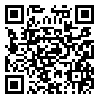Volume 16, Issue 10 (2-2018)
JRUMS 2018, 16(10): 983-990 |
Back to browse issues page
Download citation:
BibTeX | RIS | EndNote | Medlars | ProCite | Reference Manager | RefWorks
Send citation to:



BibTeX | RIS | EndNote | Medlars | ProCite | Reference Manager | RefWorks
Send citation to:
Behzadi Z, Parham S, Fata A, Najafzadeh M J. The Molecular Identification of Dermatophytes in Patients Suspected to Dermatophytosis in Ghayen (South Khorasan Province) in 2015-16 :
A Short Report
. JRUMS 2018; 16 (10) :983-990
URL: http://journal.rums.ac.ir/article-1-4012-en.html
URL: http://journal.rums.ac.ir/article-1-4012-en.html
Mashhad University of Medical Sciences
Abstract: (4555 Views)
Background and Objectives: Dermatophytes are one of the most prevalent agent of superficial fungal infections. Dermatophytes species identification can help us to find prevention and treatment ways. Therefore, this study was conducted to determine the species of dermatophytes by sequencing method in 2015-2016 in Ghayen.
Materials and Methods: This descriptive cross-sectional study was performed on 156 dermatophytosis suspected patients, who referred to the laboratories and health centers in Ghayen. Patients were sampled after completing the questionnaire. Specimens were directly examined, and all samples were inoculated on Sabouraud Dextrose Agar with Chloramphenicol and Cycloheximide medium. The DNA of the obtained fungi was extracted by DNA extraction Kit. Then, the internal transcribed spacer (ITS-rDNA) gene was amplified and sequenced, and the dermatophytes species were expressed as numbers and percentages.
Results: Of 156 samples, 32 samples (20.5%) were positive in the direct exam or culture. The types of Tinea in this study were respectively: Tinea corporis (72 %), tinea capitis (21.8 %), tinea manuum and tinea unguium (3.1 %) each one. Dermatophytes species included Arterodermabenhamiae (25%), Trichophyton interdigitale (9.3%), T. violaceum and T. verrucosum (6.2%) each one, and T.erinacei (3.1%). The comparison of the sequence of the derived species with the sequence of reference dermatophytes in wester-dijkinstitute showed 98-100% similarity.
Conclusion: According to this study, the incidence of dermatophytosis in Ghayen is 20.5% . The Trichophyton genus and zoophilic species are dominant in this area.
Key words: Dermatophytosis, Molecular Identification, Ghayen
Funding: This research was funded by mashhad University of Medical Sciences
Conflict of interest: None declared.
Ethical approval: None declared.
How to cite this article: Behzadi Z, Parham S, Fata A.M, Najafzadeh M.J.The Molecular Identification of Dermatophytes in Patients Suspected to Dermatophytosis in Ghayen (South Khorasan Province) in 2015-16 : A Short Report. J Rafsanjan Univ Med Sci 2018; 16(10): 983-90. [Farsi]
Materials and Methods: This descriptive cross-sectional study was performed on 156 dermatophytosis suspected patients, who referred to the laboratories and health centers in Ghayen. Patients were sampled after completing the questionnaire. Specimens were directly examined, and all samples were inoculated on Sabouraud Dextrose Agar with Chloramphenicol and Cycloheximide medium. The DNA of the obtained fungi was extracted by DNA extraction Kit. Then, the internal transcribed spacer (ITS-rDNA) gene was amplified and sequenced, and the dermatophytes species were expressed as numbers and percentages.
Results: Of 156 samples, 32 samples (20.5%) were positive in the direct exam or culture. The types of Tinea in this study were respectively: Tinea corporis (72 %), tinea capitis (21.8 %), tinea manuum and tinea unguium (3.1 %) each one. Dermatophytes species included Arterodermabenhamiae (25%), Trichophyton interdigitale (9.3%), T. violaceum and T. verrucosum (6.2%) each one, and T.erinacei (3.1%). The comparison of the sequence of the derived species with the sequence of reference dermatophytes in wester-dijkinstitute showed 98-100% similarity.
Conclusion: According to this study, the incidence of dermatophytosis in Ghayen is 20.5% . The Trichophyton genus and zoophilic species are dominant in this area.
Key words: Dermatophytosis, Molecular Identification, Ghayen
Funding: This research was funded by mashhad University of Medical Sciences
Conflict of interest: None declared.
Ethical approval: None declared.
How to cite this article: Behzadi Z, Parham S, Fata A.M, Najafzadeh M.J.The Molecular Identification of Dermatophytes in Patients Suspected to Dermatophytosis in Ghayen (South Khorasan Province) in 2015-16 : A Short Report. J Rafsanjan Univ Med Sci 2018; 16(10): 983-90. [Farsi]
Type of Study: Research |
Subject:
Parasitology
Received: 2017/10/16 | Accepted: 2018/02/19 | Published: 2018/02/19
Received: 2017/10/16 | Accepted: 2018/02/19 | Published: 2018/02/19
Send email to the article author
| Rights and permissions | |
 |
This work is licensed under a Creative Commons Attribution-NonCommercial 4.0 International License. |






